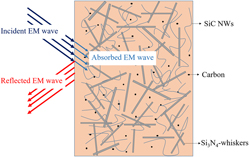Crossref Citations
This article has been cited by the following publications. This list is generated based on data provided by
Crossref.
2017.
Errata.
Journal of Materials Research,
Vol. 32,
Issue. 12,
p.
2447.
Xiao, Shanshan
Mei, Hui
Han, Daoyang
Yuan, Wenyu
and
Cheng, Laifei
2018.
Porous (SiCw-Si3N4w)/(Si3N4-SiC) composite with enhanced mechanical performance fabricated by 3D printing.
Ceramics International,
Vol. 44,
Issue. 12,
p.
14122.
Hong, Yi-Sheng
Lu, Xiao-Feng
Zhu, Xiao-Lei
Zhang, Kai-Lun
and
Chen, Mingji
2018.
3D printed honeycomb spacers: Tailoring sandwich structures for enhanced electromagnetic shielding.
Journal of Reinforced Plastics and Composites,
Vol. 37,
Issue. 16,
p.
1072.
Lv, Xinyuan
Ye, Fang
Cheng, Laifei
Fan, Shangwu
and
Liu, Yongsheng
2019.
Binder jetting of ceramics: Powders, binders, printing parameters, equipment, and post-treatment.
Ceramics International,
Vol. 45,
Issue. 10,
p.
12609.
Wen, Qingbo
Yu, Zhaoju
Liu, Xingmin
Bruns, Sebastian
Yin, Xiaowei
Eriksson, Mirva
Shen, Zhijian James
and
Riedel, Ralf
2019.
Mechanical properties and electromagnetic shielding performance of single-source-precursor synthesized dense monolithic SiC/HfCxN1−x/C ceramic nanocomposites.
Journal of Materials Chemistry C,
Vol. 7,
Issue. 34,
p.
10683.
Liu, Peijiang
Chen, Shuixian
Yao, Min
Yao, Zhengjun
Ng, Vincent Ming Hong
Zhou, Jintang
Lei, Yiming
Yang, Zhihong
and
Kong, Ling Bing
2020.
Double-layer absorbers based on hierarchical MXene composites for microwave absorption through optimal combination.
Journal of Materials Research,
Vol. 35,
Issue. 11,
p.
1481.
Zhou, Shixiang
Mei, Hui
Chang, Peng
Lu, Mingyang
and
Cheng, Laifei
2020.
Molecule editable 3D printed polymer-derived ceramics.
Coordination Chemistry Reviews,
Vol. 422,
Issue. ,
p.
213486.
Wang, Zixuan
Yu, Qi
Nie, Weicheng
and
Chen, Ping
2020.
Preparation and microwave absorption properties of Ni/rGO/EP composite foam.
Journal of Materials Research,
Vol. 35,
Issue. 16,
p.
2106.
Wu, Weiwei
Wang, Zhouzhou
Ding, Shuang
Song, Aiping
and
Zhu, Dejia
2020.
Effect of infiltrant-related parameters on mechanical performance for 3DP technology.
Rapid Prototyping Journal,
Vol. 26,
Issue. 9,
p.
1647.
Pu, Jie
Guo, Lingjun
Song, Qiang
Zhang, Xuanming
Liu, Bing
Zeng, Qionghuan
Li, Yunyu
Yin, Xuemin
Yan, Ningning
Meng, Jiachen
and
Li, Hejun
2020.
Orthogonally structured graphene nanointerface for lightweight SiC nanowire-based nanocomposites with enhanced mechanical and electromagnetic-interference shielding properties.
Composites Part B: Engineering,
Vol. 202,
Issue. ,
p.
108381.
Wen, Qingbo
Yu, Zhaoju
and
Riedel, Ralf
2020.
The fate and role of in situ formed carbon in polymer-derived ceramics.
Progress in Materials Science,
Vol. 109,
Issue. ,
p.
100623.
Mostafaei, Amir
Elliott, Amy M.
Barnes, John E.
Cramer, Corson L.
Nandwana, Peeyush
and
Chmielus, Markus
2020.
WITHDRAWN: Binder jet 3D printing – Process parameters, materials, properties, and challenges.
Progress in Materials Science,
p.
100684.
Mostafaei, Amir
Elliott, Amy M.
Barnes, John E.
Li, Fangzhou
Tan, Wenda
Cramer, Corson L.
Nandwana, Peeyush
and
Chmielus, Markus
2021.
Binder jet 3D printing—Process parameters, materials, properties, modeling, and challenges.
Progress in Materials Science,
Vol. 119,
Issue. ,
p.
100707.
Zhu, Wenxia
Chen, Zhiwei
Liang, Ji
and
Su, Dong
2022.
A laminated carbon nanotubes/silicon boron carbonitride film for high-efficiency electromagnetic interference shielding with oxidation resistance.
Carbon,
Vol. 197,
Issue. ,
p.
65.
Dong, Xingjie
Wu, Jianqin
Yu, Honglin
Zhou, Qing
Wang, Wenqing
Zhang, Xueqin
Zhang, Lu
Li, Ling
and
He, Rujie
2022.
Additive manufacturing of silicon nitride ceramics: A review of advances and perspectives.
International Journal of Applied Ceramic Technology,
Vol. 19,
Issue. 6,
p.
2929.
Chaudhary, Raghvendra Pratap
Parameswaran, Chithra
Idrees, Muhammad
Rasaki, Abolaji Sefiu
Liu, Changyong
Chen, Zhangwei
and
Colombo, Paolo
2022.
Additive manufacturing of polymer-derived ceramics: Materials, technologies, properties and potential applications.
Progress in Materials Science,
Vol. 128,
Issue. ,
p.
100969.
Yu, Siwen
Zeng, Tao
Yang, Yipeng
Jiang, Honghao
Wu, Rina
Fan, Meiling
and
Cheng, Su
2023.
Effect of an annealing treatment on the microstructure and EMW-absorbing properties of SiCw/Si3N4 ceramics fabricated by 3D printing.
Ceramics International,
Vol. 49,
Issue. 1,
p.
1092.
Feng, Yurun
Guo, Xue
Elsayed, Hamada
Huang, Kai
Franchin, Giorgia
Motz, Guenter
Tong, Yanchun
Gong, Hongyu
and
Colombo, Paolo
2023.
Enhanced electromagnetic microwave absorption properties of SiCN(Fe) ceramics produced by additive manufacturing via in-situ reaction of ferrocene.
Ceramics International,
Vol. 49,
Issue. 15,
p.
25051.
Yang, Leipeng
Liu, Xin
Xiao, Yuan
Liu, Bing
Xue, Zhuo
and
Wang, Yuping
2023.
Additive manufacturing of carbon nanotube/polylactic acid films with efficient electromagnetic interference shielding and electrical heating performance via fused deposition modeling.
Synthetic Metals,
Vol. 293,
Issue. ,
p.
117258.
Zhu, Wenxia
Tian, Zhengkai
Yan, Xiao
and
Su, Dong
2023.
Carbon nanofiber aerogel/silicon oxycarbide composites for enhanced electromagnetic interference shielding.
Surface Innovations,
Vol. 11,
Issue. 1-3,
p.
132.
